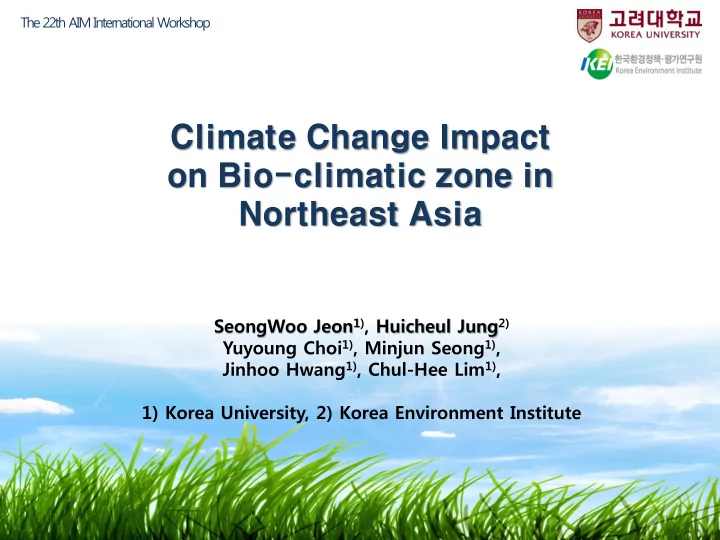

The 22th AIM International Workshop Climate Change Impact on Bio-climatic zone in Northeast Asia SeongWoo Jeon 1) , Huicheul Jung 2) Yuyoung Choi 1) , Minjun Seong 1) , Jinhoo Hwang 1) , Chul-Hee Lim 1) , 1) Korea University, 2) Korea Environment Institute
Ⅰ Ⅱ Ⅲ Ⅳ
Ⅰ What is bio-climatic map?
Ⅰ What is bio-climatic map? Bioclimatic Climate classification Land Geological & Soil Vegetation Ecoregion Animal Ecodistrict Conceptual model of ecosystem (Klijin & deHaes, 1994)
Ⅰ Why do we need “Bio - climatic map”? <Examples of endangered species> Seals Gold frogs Abies Koreana
Ⅰ Goal of this study
Ⅱ Materials and Methods Flow Chart Collect data Principal (Environment, Variable Correlation ISODATA Component Socio- selection analysis clustering Analysis economic) Verification of Establishing Establishing Result with Bioclimatic map Verification of Bioclimatic map reference data in Northeast Asia the Methodology of South Korea Support Policy making Change Detection In Northeast Asia in climate change adaptation & by RCP Scenarios Biodiversity Management Strategies
Ⅱ Materials and Methods Variable selection MK-PRISM Time 2001-2010 Resolution 1km² var2 Annual Mean diurnal range Isothermality (%) var3 Maximum T of the warmest month ( ℃ ) var5 Minimun T of the coldest month ( ℃ ) var6 var7 Annual T range Growing degree-days on 5 ℃ base var12 Variables Precipitation seasonality (%) var23 var26 Precipitation of warmest quarter var27 Precipitation of coldest quarter var43 MTCI(Minimum Temperature Index of the Coldest Month) var44 PEI (Precipitation Effectiveness Index) var45 WI (Warmth Index)
Ⅱ Materials and Methods Correlation analysis Using software R • Removing var6, var12 • Selection of independent • variables
Ⅱ Materials and Methods Principle Component Analysis (PCA) PC1 PC2 PC3 PC4 PC5 PC1 var2 0.399687 0.119999 0.399656 -0.02064 0.032238 • Var2 : Annual Mean diurnal range var3 0.269583 0.160389 0.63227 -0.03946 0.32184 • Var7 : Annual Temperature range var5 -0.07493 0.568793 0.206798 -0.06105 -0.3348 • Var43 : MTCI var7 0.443237 0.050907 0.055942 -0.01609 -0.28685 (Minimum Temperature Index of the Coldest Month) var23 0.360238 0.079313 -0.33288 -0.38404 -0.48391 var26 -0.30661 -0.15662 0.214062 -0.77926 0.060588 PC2 var27 -0.30081 -0.22184 0.365121 0.430635 -0.54578 • Var5 : Maximum T of the warmest month( ℃ ) var43 0.416556 -0.24087 -0.04694 0.035574 -0.10728 var44 -0.03117 -0.52344 0.315664 -0.20358 -0.31117 • Var44: PEI (Precipitation Effectiveness Index) var45 -0.27703 0.470874 0.053116 -0.10554 -0.23866 • Var45 : WI (Warmth Index) S t a n d a r d 2.1625 1.6238 1.1501 0.80382 0.63948 d e v i a t i o n PC3 P r o p o r t i o n o f 0.4677 0.2637 0.1323 0.06461 0.04089 • Var3 : Isothermality (%) V a r i a n c e C u m u l a t v i e 0.4677 0.7313 0.8636 0.92823 0.96913 P r o p o r t i o n
Ⅱ Materials and Methods ISODATA clustering • PC1 : Red band • PC2: Green band • PC3: Blue band • ISODATA (The Iterative Self-Organizing Data Analysis Technique) This technique is used widely in image analysis fields, such as remote sensing ISODATA is iterative in that it repeatedly performs an entire classification and recalculates statistics Self-organizing refers to the way in which it locates clusters within minimum user input
Ⅱ Materials and Methods 20 bio-climatic zones of South Korea • Sensitivity analysis by various bio-climatic zones • Compare with existed reference vegetation map and forest map
Ⅲ Results Verification Pearson Correlation coefficient : -0.6074 Pearson Correlation coefficient : -0.6243
Ⅲ Results Bioclimatic map of South Korea – Regional Characteristics Summe Annual Summe Winter Winter Annual Summer Winter r AREA Zo DEM Mean r Mean Mean lowest Precipi- Precipi- Precipi- (100 만 highest ne ( m) Temp Temp Temp Temp tation tation tation Temp km²) ( ℃ ) ( ℃ ) ( ℃ ) ( ℃ ) ( mm) (mm) (mm) ( ℃ ) 1 4439 158.51 13.44 23.49 3.14 28.50 -1.89 1359.50 602.07 135.69 2 4192 56.09 12.81 24.13 0.97 29.75 -4.64 1205.16 608.16 111.62 3 4021 77.18 13.49 23.97 2.40 29.55 -3.45 1223.65 577.23 107.48 4 4042 44.57 11.51 23.79 -1.94 29.47 -8.50 1291.87 750.36 72.58 5 4372 246.49 12.40 22.74 1.53 28.07 -4.13 1510.72 690.69 134.78 6 4018 200.06 12.48 23.58 0.71 29.35 -5.37 1305.43 660.06 109.43 7 3587 91.10 11.79 23.51 -0.62 29.39 -6.86 1235.38 655.53 97.37 8 6012 188.82 12.46 23.14 1.14 28.97 -5.04 1375.67 669.74 117.83 9 4729 173.57 12.37 23.50 0.45 29.40 -6.39 1214.32 633.03 90.18 10 6710 140.86 12.09 23.76 -0.43 29.79 -7.28 1073.59 578.16 75.57 11 6991 300.93 11.62 23.08 -0.54 29.22 -7.40 1396.09 760.73 103.97 12 5239 138.43 11.06 23.59 -2.55 29.51 -9.80 1263.65 711.82 81.15 13 8654 216.59 11.39 23.26 -1.28 29.25 -7.97 1252.16 684.92 93.89 14 5155 284.46 10.34 22.69 -3.06 28.76 -10.38 1266.83 711.59 85.81 15 3376 166.16 10.53 23.15 -3.36 28.88 -10.79 1429.55 869.05 71.00 16 3926 601.20 8.56 20.50 -4.35 26.20 -11.32 1396.51 757.50 104.49 17 4647 311.00 9.60 22.27 -4.29 28.18 -12.06 1343.84 780.90 79.47 18 4014 538.97 9.99 21.17 -1.96 26.89 -8.28 1483.69 765.06 124.35 19 3074 566.83 7.91 20.48 -5.85 26.07 -13.37 1443.83 843.56 84.77 20 4098 888.58 6.68 18.40 -5.99 23.70 -12.69 1568.19 820.01 129.87
Ⅲ Results Expansion to Northeast Asia <PCA stack> <29 zones>
Ⅲ Results Expansion to Northeast Asia <35 zones> <55 zones>
Ⅲ Results Expansion to Northeast Asia Overlay with Isothermality (%) Pearson Correlation coefficient : -0.5894
Ⅲ Results Examples of application <mean of 1960-1990> <mean of 1970-2000>
Ⅲ Results Change detection Bioclimatic zones of South Korea (Left: current, Right: future) To observe changes in the region due to climate change, future scenario data of HadGEM2-AO(RCP8.5, 2070s) was used. Further study should be needed for quantitative comparison of each zonal changes and then this could be used more effectively to support decision making on climate change adaptation.
Ⅳ Conclusion Significance and limitations
Ⅳ Conclusion Research plan linked with UNCDF
Thank you for your attention
Recommend
More recommend